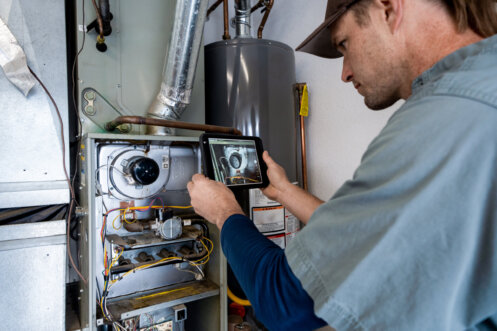Electric Furnaces: How They Work and Understanding the Pros and Cons
Electric furnaces are a common heating option in California. An electric furnace can effectively keep your home warm as long as the outside temperature doesn’t get too cold. It will also tend to cost less to install than most other heating options. Despite the lower price, an electric furnace isn’t always the best option, as your heating costs will almost always be higher with this type of unit. To help you understand why this is, here’s an overview of how electric furnaces work and how they compare to other heating options.
How Electric Furnaces Produce Heat
Electric furnaces and gas furnaces both use a heat exchanger that transfers heat energy to the cool air flowing through the furnace. The difference between the two is how they produce heat and how the heat exchanger works. Gas furnaces obviously burn gas to produce hot flames. The heat from the flames rises up into a metal heat exchanger that then captures much of the heat. When cool air flows over the heat exchanger, all of the heat the exchanger stores is transferred from the metal into the air.
Electric furnaces typically have between three and six electric resistance coils or heating elements located inside the heat exchanger. Each heating element is made from a metal wire that’s tightly wrapped into coils. The metal wires in an electric resistance heating element are similar to the wires inside of a toaster. As electricity flows through the wires and meets resistance, the wires almost instantly heat to the point where they’re red hot and glowing. As cold air moves through the heat exchanger, the heat radiating from the resistance coils is naturally absorbed by the air, instantly making it much hotter.
The reason that the electric resistance coils produce heat has to do with what happens when electricity flows through or meets metal. Electricity always causes any metal to quickly become extremely hot. This is because metals are resistant to the flow of electricity. Electricity is simply the movement of electrons between different atoms. When electricity flows through any type of metal, the electrons meet resistance and collide with ions in the metal. These collisions produce lots of heat, causing the metal to quickly become hot.
How Much Energy Does an Electric Furnace Use?
Electric furnaces are always more efficient than gas furnaces. They’re also cleaner and better for the environment since electric heating doesn’t produce carbon emissions like burning natural gas or propane does. The energy efficiency of any type of heating is measured in terms of how many units of heat energy the unit produces compared to how many units of energy it uses.
The energy efficiency of modern gas furnaces ranges between 80% to 98.5%. A gas furnace that’s 80% efficient produces eight units of heat energy for every 10 units of gas it burns. The other two units of energy the unit uses are wasted or lost, which is because the metal heat exchanger can only absorb so much heat from the hot fumes flowing through it. Some latent heat always remains in the fumes when they rise out of the heat exchanger and flow up through the exhaust flue, which results in some of the heat energy being wasted.
Electric furnaces and all other types of electric resistance heating like space heaters and baseboard heaters are always 100% efficient. This means that the electrical energy they use is always directly converted into heat energy at a one-to-one ratio. In other words, electric resistance heaters produce one unit of heat energy for every single unit of electrical energy they use. This is because all of the heat released by the resistance coils in an electric furnace remains trapped within the heat exchanger and naturally flows out into the air, so there’s no energy waste like there is when burning gas. Space heaters and baseboard heaters don’t have a heat exchanger, but all of the heat emanating from the coils still flows out into the surrounding air.
Despite being more energy-efficient, an electric furnace will almost always cost more to operate than a similar sized gas furnace. This is partly because electricity rates tend to be quite a bit higher than natural gas rates in most places. The other reason is simply because electric furnaces use a huge amount of electricity.
In California, you typically need a unit that produces somewhere around 30 to 35 BTUs of heat for each square foot in your home to heat it effectively. A 1,500-square-foot house would typically need a minimum of 45,000 BTUs of heating. This means that you’d normally need between a 15- and 20-kilowatt electric furnace to ensure your home stays sufficiently warm. To cool the same size house in your area, you’d normally need a 3- or 4-ton air conditioner. Depending on its energy efficiency rating, this size of AC unit would normally use anywhere between 2.5 and 5 kilowatts per hour (kWh).
Comparing the kWh difference between an electric furnace and an air conditioner easily shows you just how much energy an electric furnace uses. The fact that the winters in California tend to be fairly mild means that an electric furnace will never run nearly as much as an air conditioner. Nonetheless, when an electric furnace does need to run, it will use far more electricity than an AC unit would if it ran for the same amount of time.
Comparing Electric Furnaces and Heat Pumps
Converting your home to electric heating can definitely help to lower your carbon footprint, but opting for a heat pump will always be the better and more energy-efficient option compared to an electric furnace. Heat pumps also run on electricity, but unlike an electric furnace, they don’t just convert electricity into heat. Instead, they use the electricity to move heat from outside into the house using refrigerant.
Heat pumps can heat and cool, and they work just like any other type of air conditioner when cooling. However, they can also switch so that instead of using the refrigerant to remove heat from the home, the refrigerant removes heat from the air outside and releases it indoors. This is possible due to a heat pump’s expansion valve and reversing valve.
The reversing valve allows a heat pump to reverse the direction of the refrigerant flow. Instead of having cold refrigerant flowing into the house as the unit does when cooling, it switches so that cold refrigerant flows through the coil in the heat pump outside the home. That way, the system can capture heat from the outdoor air and pull it inside the building.
As refrigerant moves through the heat pump, it first absorbs enough heat from the air that it changes from a cold liquid to a hot liquid. The semi-heated refrigerant then passes through the expansion valve, which causes the refrigerant to boil and instantly change into a superheated gas. As the heated gas refrigerant moves inside the home and enters the coil in the air handler, it automatically releases all of the heat and instantly raises the temperature of the air moving through the ductwork and flowing over the coil.
The fact that heat pumps use electricity to capture and transfer heat instead of just converting it directly into heat makes them far more energy-efficient. Although the energy efficiency of a heat pump does start to decrease in colder weather, a heat pump will still typically be around 60%-70% more energy-efficient than an electric furnace. The fact that a heat pump can also cool your home provides an added benefit. All you’ll need is one unit to keep your home cool in the summer and hot in the winter instead of needing to install and maintain a furnace and a traditional air conditioner.
Crystal Blue Heating, Plumbing and Air specializes in all types of heating installation, and our team can help if you’re looking to install a heat pump or any type of furnace. We also offer professional heating and air conditioning maintenance services. Plus, we can repair any issue your HVAC system may have. To learn more about your heating options or to schedule any HVAC service in the Sacramento area, give us a call today.







